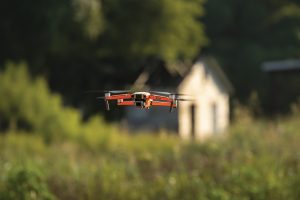Home > Mississippi > High-Tech Tools Help Farmers Produce More With Less
High-Tech Tools Help Farmers Produce More With Less
In partnership with: Mississippi Department of Agriculture and Commerce

On a searing July morning in Tallahatchie County, Chad Swindoll uses an app on his phone to remotely switch on an electric irrigation well. When the irrigation is completed, the pump can be shut off the same way. This simple act illustrates the technology today’s farmers have at their fingertips.
See more: Young Farmers Utilize Technology to Connect, Innovate
Smart Farming
GPS satellites communicate with combines to monitor harvest yields in real time. Drones flying over fields can spot plant disease or indicate the need for plant growth regulator. And GPS signals guide planters and sprayers to distribute their inputs at variable rates. These and other technologies are used in precision agriculture, making production more efficient by using fewer resources, thereby reducing environmental impact and farmers’ costs.
“Most people outside of agriculture don’t have a clue how high-tech farming has become,” says Chad Swindoll, who has a unique perspective on the subject.
He considers himself blessed to have grown up in a farming family with the opportunity to learn and implement some of the technology in his family’s and in his own farm business. He also worked as a field representative for a precision ag tech company. During his years in the industry, he was constantly asked by his farming customers, “Can you help me with my data?” Swindoll eventually formed a consultancy – J19 Agriculture – advising farmers and agribusinesses in the use, management and implementation of agriculture information.
Better Information, Better Yields
To make the best decisions using ag information, collecting data is a critical first step. At Southern Soil & Plant Lab in Yazoo City, co-owners Dee Boykin and his nephew and namesake Dee Nelson Boykin provide analysis of both soil and plant tissue. Lab results are fed into precision ag software to create soil fertility maps that give the grower geo-specific locations, so each section of the field gets the fertilizer it needs, and no more.
“Although variable rate application practices have been in use for 20 years, improvements in equipment and software yield more and better information,” says Dee Nelson, who serves as lab manager. “The precision findings from soil testing allow growers to reduce their use of fertilizer nearly every time.”
The Boykins also offer multispectral imagery of cotton fields using drones. This imagery measures both photosynthetic activity and changes in chlorophyll content and allows producers to apply plant growth regulator exactly where it’s needed.
“In adopting precision ag practices, the ultimate goal is to increase yields with fewer inputs,” says Dee, who has served as an ag consultant for nearly 40 years.

See more: Digital Marketing and Technology Help Producers Connect With the Public
Learning Curve with Technology
Advancements in equipment, biotech seeds and precision applications of fertilizer and herbicide give growers tremendous capabilities. However, Dee says farmers don’t always utilize all the technology they have access to. A lack of time is one problem, along with not having a complete understanding of how to gather information from their equipment or what
to do with the data when they have it.
More and more growers, however, are finding ways to increase their use of precision ag practices for several reasons. One is that they believe ag information is going to be even more important in the future. Another key motivation has to do with growers’ desire to use as little fertilizer or herbicide as possible, for both monetary and conservation reasons. Swindoll says both of those beliefs drive farmers to invest in services like the one he provides.
“Every farmer is a conservationist and a businessperson,” Swindoll says. “Farmers are dependent on the land, so it’s just common sense that they’re doing all they can to preserve it to protect their livelihoods.”

See more: Technology Delivers Comfort and Convenience for Mississippi Poultry



